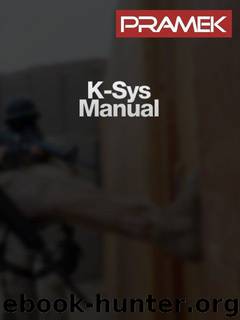K-Sys: An American Understanding of Kadochnikov's System by Powell Matthew

Author:Powell, Matthew [Powell, Matthew]
Language: eng
Format: epub
Publisher: Unknown
Published: 2003-06-09T16:00:00+00:00
With the assistance of the levered cranes, the Roman ships were lifted from the water and then dropped, destroying the ships. Cranes with hooks were also constructed. The hooks would sit in the water waiting for a ship to float over them. Once ships floated over the hooks, soldiers would then lift the hooks with the use of cranes, pulling the ships out of the water, and dropping them. Levers are simple machines of nature with extraordinary potential for use in force application in combat.
35
A lever is any solid body that can revolve around an axis under the action of the specific forces (such forces must be not less than two). The fundamental law of the lever: A lever is in equilibrium if the two forces acting upon a lever are equal (Fig. 4.6). If there is an inequality in these forces, a rotation will occur around the axis to the side of the large moment of force (Fig. 4.7).
Figure 4.6 Figure 4.7
A lever has the following elements:
- fulcrum (rotational axis);
- at the minimum, two forces (F1 and F2);
- the point of the application of force;
- lever arms (distance from the fulcrum to the points of application of force);
- arm of force (shortest distance from the fulcrum to the force lines once lowered to a point of
being perpendicular).
In a single-arm lever, forces are applied on one side of the rotational axis and directed at the opposite side (Fig. 4.8). A common example is a scale (Fig. 4.9).
Figure 4.8 Figure 4.9 .
When the effective force is applied to the long arm, the lever is called a lever of force (Fig. 4.10). A common example of a lever of the second classification is a wheelbarrow (Fig. 4.11). In this lever, the mechanical advantage creates a loss in speed for distance to occur.
Figure 4.10 Figure 4.11
n the third lever, the effective force is applied to the shorter arm and called the lever of speed (Fig. 4.12). The lever of this kind is considered to be "pincers" - which gains in the speed and the distance, but loses in force (Fig. 4.13).
36
Figure 4.12 Figure 4.13
For a practical combat example, in order to overcome a counter force, one must either increase the force, which will accomplish work, or increase the length of the arm. In hand to hand fighting, force is applied to an enemy in order to accomplish work, and the enemy must produce counter forces to neutralize or overcome such forces.
Other forms of machines
Download
This site does not store any files on its server. We only index and link to content provided by other sites. Please contact the content providers to delete copyright contents if any and email us, we'll remove relevant links or contents immediately.
Unstoppable by Maria Sharapova(3136)
The Inner Game of Tennis by W. Timothy Gallwey(3027)
Urban Outlaw by Magnus Walker(2969)
Crazy Is My Superpower by A.J. Mendez Brooks(2886)
The Social Psychology of Inequality by Unknown(2342)
The Fight by Norman Mailer(2177)
Unstoppable: My Life So Far by Maria Sharapova(2144)
Going Long by Editors of Runner's World(1938)
Accepted by Pat Patterson(1931)
Motorcycle Man by Kristen Ashley(1882)
The Happy Runner by David Roche(1845)
The Sports Gene: Inside the Science of Extraordinary Athletic Performance by David Epstein(1837)
Backpacker the Complete Guide to Backpacking by Backpacker Magazine(1836)
Futebol by Alex Bellos(1819)
Sea Survival Handbook by Keith Colwell(1808)
Mind Fuck by Manna Francis(1769)
Peak: Secrets from the New Science of Expertise by Anders Ericsson & Robert Pool(1683)
Endure by Alex Hutchinson(1628)
The Call of Everest by Conrad Anker(1566)
